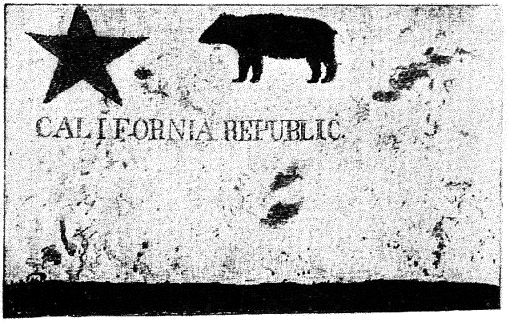|
The California Bear Flag

Historic California Bear Flag as photographed in 1890.
This flag, raised at Sonoma on June 14, 1846, was in the possession of
the Society of California Pioneers at the time of the 1906 Great Earthquake
and Fire, and burned during the conflagration.
According to the California Blue Book:
“The flag was designed by William Todd on a piece of new unbleached
cotton. The star imitated the lone star of Texas. A grizzly bear represented
the many bears seen in the state. The word, ‘California Republic’
was placed beneath the star and bear. The Bear Flag was replaced by the
American flag. It was adopted by the 1911 State Legislature as the State
Flag. ”
California pioneer John Bidwell chronicled many of the events surrounding
the “Bear Flag Revolt,” and wrote, in 1890:
“Among the men who remained to hold Sonoma was William B. Ide,
who assumed to be in command. In some way (perhaps through an unsatisfactory
interview with Frémont which he had before the move on Sonoma),
Ide got the notion that Frémont's hand in these events was uncertain,
and that Americans ought to strike for an independent republic. To this
end nearly every day he wrote something in the form of a proclamation and
posted it on the old Mexican flagstaff. Another man left at Sonoma was
William L. Todd who painted, on a piece of brown cotton, a yard and a half
or so in length, with old red or brown paint that he happened to find,
what he intended to be a representation of a grizzly bear. This was raised
to the top of the staff, some seventy feet from the ground. Native Californians
looking up at it were heard to say ‘Coche,’ the common name among them
for pig or shoat. More than thirty years afterwards I chanced to meet Todd
on the train coming up the Sacramento Valley. He had not greatly changed,
but appeared considerably broken in health. He informed me that Mrs. Lincoln
was his own aunt, and that he had been brought up in the family of Abraham
Lincoln.”
See John Bidwell's “Frémont
in the Conquest of California,” for details of the Bear Flag and the California Republic.
Return to the top of the page.
|